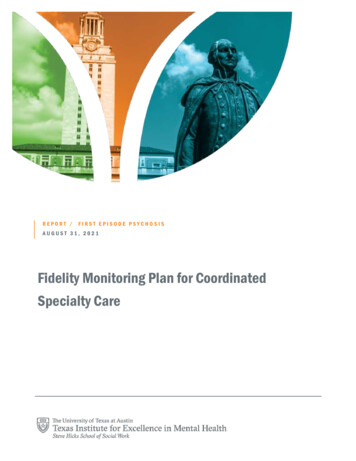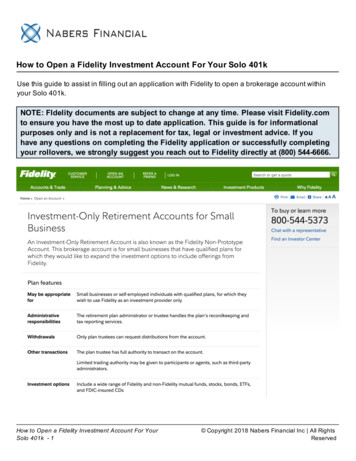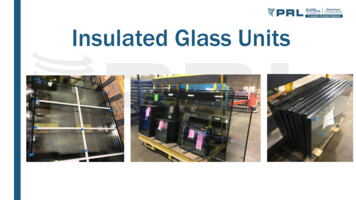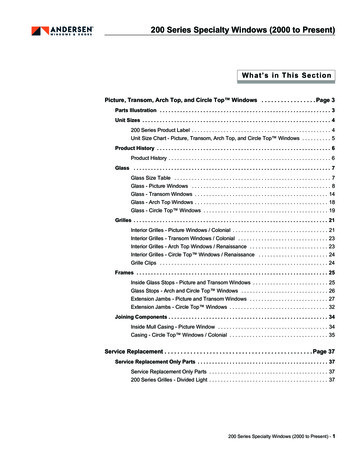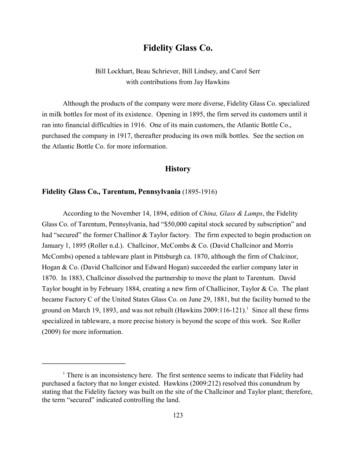
Transcription
Fidelity Glass Co.Bill Lockhart, Beau Schriever, Bill Lindsey, and Carol Serrwith contributions from Jay HawkinsAlthough the products of the company were more diverse, Fidelity Glass Co. specializedin milk bottles for most of its existence. Opening in 1895, the firm served its customers until itran into financial difficulties in 1916. One of its main customers, the Atlantic Bottle Co.,purchased the company in 1917, thereafter producing its own milk bottles. See the section onthe Atlantic Bottle Co. for more information.HistoryFidelity Glass Co., Tarentum, Pennsylvania (1895-1916)According to the November 14, 1894, edition of China, Glass & Lamps, the FidelityGlass Co. of Tarentum, Pennsylvania, had “ 50,000 capital stock secured by subscription” andhad “secured” the former Challinor & Taylor factory. The firm expected to begin production onJanuary 1, 1895 (Roller n.d.). Challcinor, McCombs & Co. (David Challcinor and MorrisMcCombs) opened a tableware plant in Pittsburgh ca. 1870, although the firm of Chalcinor,Hogan & Co. (David Challcinor and Edward Hogan) succeeded the earlier company later in1870. In 1883, Challcinor dissolved the partnership to move the plant to Tarentum. DavidTaylor bought in by February 1884, creating a new firm of Challicinor, Taylor & Co. The plantbecame Factory C of the United States Glass Co. on June 29, 1881, but the facility burned to theground on March 19, 1893, and was not rebuilt (Hawkins 2009:116-121).1 Since all these firmsspecialized in tableware, a more precise history is beyond the scope of this work. See Roller(2009) for more information.1There is an inconsistency here. The first sentence seems to indicate that Fidelity hadpurchased a factory that no longer existed. Hawkins (2009:212) resolved this conundrum bystating that the Fidelity factory was built on the site of the Challcinor and Taylor plant; therefore,the term “secured” indicated controlling the land.123
According to Hawkins (2009:211-212), the company was started by striking glassblowers from the C.L. Flaccus Glass Co. who were unhappy with mechanization. Henry S.Brackenridge was the president, with J.G. Vogeley as vice president, J. Frank Peffer as secretary,and J.F. Humes as treasurer. Other board members included John Grant, H.S. Humes, ThomasO’Malley, and William Goss. China, Glass & Lamps (5/15/1895) reported that H.E. Travis wasthe superintendent of the plant, and Charles Gass was the manager (cited in Roller n.d.).2Secondary sources (e.g., Toulouse 1971:29) have noted that the plant was atBrackenridge, Pennsylvania, and Hawkins (2009:211) agreed that the Brackenridge location“was listed by some contemporary sources.” However, the actual factory was situated at nearbyTarentum, about a mile southwest of Brackenridge. Both are roughly 10 miles northeast ofPittsburgh, along the Allegheny River. Some of the confusion may have arisen because theinitial president of Fidelity was Henry S. Brackenridge. It is also possible that an office waslocated at Brackenridge.The plant originally had a 16-pot furnace and was still making “flint bottles” in “sixteenpots” in 1897. By 1898, the plant had two furnaces with 28 pots, but the number decreased to16 pots in 1900 (probably indicating that only one furnace was working at the time the reportwas written) and was back up to 28 in 1901 and 1902 (Hawkins 2009:211; National GlassBudget 1897a:7; 1897b:5; 1898a:7; 1898b:3; 1900:11; 1901:11; 1902:11). In 1904, the plantmade “prescription and packers’ ware, milk jars (American Glass Review 1934:167).A listing of factories using semiautomatic machines in 1905 noted a plant in Tarentumwith “six bottle machines making milk jars, pints and quarts, salt and pepper shakers” (NationalGlass Budget 1912a:1). At least some of those machines (especially making milk jars) almostcertainly belonged to Fidelity Glass, although the C.L. Flaccus Glass Co. also had a plant in2Travis later formed the Travis Glass Co. (1908). See the section on Travis Glass formore information. Vogeley Peffer were a local businessmen, involved with several Tarentumfirms – hardly glass men. We found nothing about Brackenridge at Tarentum – aside from theFidelity connection. Charles Gass, on the other hand, was connected with the union by at least1903 – a solid glass connection. This all questions the idea that Fidelity was begun bydissatisfied Flaccus blowers. We can find no Flaccus connection with either Travis or Gass, andthe others were certainly financiers. It also seems strange that blowers would develop a machinefirm.124
Tarentum and used semiautomatic machines. The Thomas Register (1907-1908:161, 799;1917:731) listed the plant as making prescription, packer, and preserver bottles from 1907 to1917. By 1912, the operation had switched to two continuous tanks with 19 rings, and thefactory used two continuous tanks with 19 rings to make a general line of bottles by bothsemiautomatic machine and hand production the following year (Hawkins 2009:211; Journal ofIndustrial and Engineering Chemistry 1913:953).Toulouse (1971:29) stated that Fidelity experienced financial difficulties in 1916, and theAtlantic Bottle Co., always before a jobber rather than a manufacturer, bought the factory andbegan making its own milk bottles.3 Even though Atlantic Glass operated the plant under itsown name, the factory was listed locally under its former name (Fidelity) until 1930, when theOwens-Illinois Glass Co. purchased Atlantic (Hawkins 2008). The American Glass Review(1934:167) also claimed (incorrectly) that the “Anchor Bottle Co.” took over the plant in 1917.Containers and MarksF (ca. 1910-1916)Hawkins (2009:212) illustrated an “F” mark, accompanied bythe word “FIDELITY,” embossed on the base of a single mouthblown milk bottle used by a Pennsylvania dairy. He stated that thebottle was “attributed to the Fidelity Glass Co. (Figure 1). Thissuggests that an “F” on a milk bottle base may indicate a manufactureby Fidelity. Hawkins did not suggest any date range for the bottle,but it was almost certainly within the ca. 1910-1916 range.3Figure 1 – Fidelity and F(Jay Hawkins)Toulouse (1971:396), however, told a second story about the same company, claimingthat the Owens Bottle Co. bought 51% of the stock for the Fidelity Glass Co., Tarentum,Pennsylvania, in 1912. We have not been able to find any records of the factory as part ofOwens, and other documentation supports the sale to Atlantic.125
FID (ca. 1910-1916)According to Giarde (1980:42), the FID mark “has beenfound on tin tops.” He attributed the mark to the Fidelity GlassCo., although he did not mention whether the bottles weremouth blown or machine made. A photo from Al Morinshowed the mark on the upper reverse body of a milk bottle –accompanied by the Massachusetts seal (see below) – that wasalmost certainly machine made (Figure 2).Figure 2 – FID on reverse(Al Morin)Brad Blodget (personal communication 2/23/2008) noted “FID. / 2” in large lettersembossed horizontally on the reverse body of a milk bottle (probably from New York)with a numeral “2” on the front heel. The mark was located on either the front or reverseheel or on the center of the reverse body. It is unlikely that the firm used any logo prior tothe Massachusetts requirements (see next entry). Although it is unclear when Fidelitybegan use of the Mass. Seal, it was not prior to 1910.In addition, 1910 was the year when the State of New York initiated the numbersystem for identifying milk bottle producers who wanted to sell containers to dairieswithin the state. The law required that manufacturers permanently mark each milk bottlesold in New York with the initials or logo of the glass house and a number assigned bythe state. Other states soon initiated similar requirements, and the designated numbersbecame an integral part of the manufacturer’s marks. All or most states assigned thenumber “2” to the Fidelity Glass Co.Jay Hawkins found an unusual variation. This one was embossed “FID. / 1” on theheel. This likely indicates that Fidelity was the first to apply for a number in one state,although the company certainly settled in at number “2.” This heelmark also could havebeen a engraver’s error or a typographical error on the part of the recorder.126
“FID” in the Massachusetts Seal (ca. 1910-1916)From 1910 to 1947, the Commonwealth ofMassachusetts required that all glass factories selling bottlesto dairies within the state mark their containers with aMassachusetts seal. From some point after 1910, factoriesembossed the seal on the shoulder of each milk bottle, usuallyin a circular form embossed “MASS (arch) / {factoryFigure 3 – Mass Seal 1designator} / “SEAL (inverted arch).” These often appeared in a small plate (Blodget2006:8; Schadlich [ca. 1990]).Schadlich ([ca. 1990]) stated, “There weremanufacturers applying the MASS SEAL to their milk bottlesor jars for which no record of approval has been found.” Oneof these seals was embossed “FID” in the center, and themark is attributed by Schadlich to the Fidelity Glass Co. HeFigure 4 – Mass Seal 2added that the Massachusetts seal was “above slug plate in arc. Front of bottle” andincluded the date range 1915-1916. We do not know how he derived the date range.The FID seal appeared in at least three configurations.Possibly the oldest was embossed “MASS. SEAL FID.” in anarch on the reverse shoulder of a bottle (Figure 3). Thesecond form was similar: “MASS. SEAL (arch) / FID.” –again on the reverse heel (Figure 4). The final format of theFigure 5 – Mass Seal 3 (eBay)seal was placed on the reverse shoulder in a circular plate,embossed “MASS SEAL (arch) / FID. (inverted arch)” (Figure 5). This is a slightlydifferent configuration from typical Massachusetts seals that had the companyidentification in the center of the seal. Al Morin’s photo (see Figure 2) showed thecircular seal with “FID. / 2” below it, and at least one milk bottle with the arched seal wasamber in color.127
FIDELITY (ca. 1910-1916)Hawkins (2009:212) noted that “FIDELITY” in an arch (along with a letter “F”)was embossed on the base of a Pennsylvania milk bottle (see Figure 1). He attributed themark to the Fidelity Glass Co. The Dairy Antiques site (2015) also attributed the logo toFidelity Glass.MAINE F-2 SEAL (1913-1916)Maine adopted a seal law in 1913 that required milk bottle manufacturers wishing to sellto dairies within the state to post a 1,000 bond and emboss the glass house initials and assignednumber on each bottle to guarantee the container was the correct size. In 1915, the law wasmodified to include the words “MAINE SEAL” and the number embossed on the upper half ofthe bottle (Public Laws of Maine 1913:78-79; 1915:28). In reality, the seal was placed on theshoulder/neck area, often in a round plate. The Dairy Antique site (2015) noted that Fidelityused the “MAINE F-2 SEAL” – although we have never found an example. Since the AtlanticBottle Co. replaced Fidelity in 1917, the logo can only be dated 1913-1916.Discussion and ConclusionsThe Fidelity Glass Co. apparently only used three logos – F, FID, and FIDELITY – onmilk bottles between ca. 1910 and 1916. The firm also applied the Mass FID seal during thesame period and the Maine FID-2 seal from ca. 1913. Although the plant also made a few otherbottle forms, we have never found one of these logos on any product except milk bottles.AcknowledgmentsWe are grateful for the proofreading of Wanda Wakkinen – whom catches interestingtypos – even in the citations.128
SourcesAmerican Glass Review1934 “Glass Factory Yearbook and Directory.” American Glass Review, Pittsburgh,Pennsylvania. Includes reprint of the “Glass Trade Directory for 1904.” CommonerPublishing Co., Pittsburgh, Pennsylvania.Blodget, Bradford2009 Milk Bottles from the Heart of the Commonwealth: A Collector’s Guide to the MilkBottles of the City of Worcester, Massachusetts, 1890-2004. Privately printed. [revisionof the 2005 edition]Dairy Antiques Site2015 “Milk Bottle Manufacturers.” Dairy Antiques Site.http://dairyantiques.com/Milk Bottle Makers.htmlGiarde, Jeffery L.1980 Glass Milk Bottles: Their Makers and Marks. Time Travelers Press, Bryn Mawr,California.Hawkins, Jay W.2009 Glasshouses & Glass Manufacturers of the Pittsburgh Region, 1795-1910.iUniverse, Inc., New York.Journal of Industrial and Engineering Chemistry1913 “The Present Status of the Glass Bottle and Hollow Ware Industries in the UnitedStates.” Journal of Industrial and Engineering Chemistry 5(11):951-954.National Glass Budget1897a “Glass Directory.” National Glass Budget 12(42):7.1897b “Flint and Green Glass Review.” National Glass Budget 13(26):4-6.129
1898a “Flint, Green and Cathedral Glass Factories of the United States and Canada inOperation.” National Glass Budget 13(38):7.1898b “Flint Bottle Factories.” National Glass Budget 14(18):3.1900 “Complete List of Glass Factories in the United States and Canada.” National GlassBudget 15(48):11.1901 “Complete List of Glass Factories in the United States and Canada.” National GlassBudget 17(1):11.1902 “Complete List of Glass Factories in the United States and Canada.” National GlassBudget 17(52):11.1912a “Changes Wrought in 7 Years.” National Glass Budget 30:1.Public Laws of Maine1913 Public Laws of Maine, Chapter 81.1915 Public Laws of Maine, Chapter 44.Roller, Dickn.d. “Tarentum, PA History Notes.” Dick Roller files.Schadlich, Louisca. 1990 “Milk Bottles Marked by Manufacturers and Jobbers.” Unpublishedmanuscript.Thomas Register of American Manufacturers1907-1908 Thomas’ Register of American Manufacturers and First Hands in all Lines:The Buyers Guide. Thomas Publishing Co., New York.130
1917 Thomas Register of American Manufacturers and First Hands in All Lines. 9th ed.Thomas Publishing Co., New York.Toulouse, Julian Harrison1971 Bottle Makers and Their Marks. Thomas Nelson, New York.Last updated 7/24/2015131
132
The Dairy Antique site (2015) noted that Fidelity used the "MAINE F-2 SEAL" - although we have never found an example. Since the Atlantic Bottle Co. replaced Fidelity in 1917, the logo can only be dated 1913-1916. Discussion and Conclusions The Fidelity Glass Co. apparently only used three logos - F, FID, and FIDELITY - on

